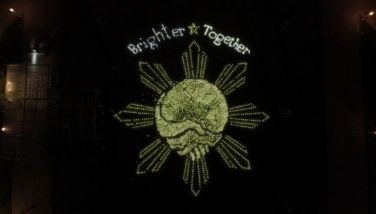Understanding the Marian Sacramentals

For many people, it is difficult to understand why millions of devotees spend long hours risking their lives and limbs participating in the annual rituals associated with the Feast of the Black Nazarene of Quiapo. Non-Catholics also wonder why Catholics make the sign of the cross, pray the rosary, and wear scapulars and medals that show the image of their favorite saints. Even among many practicing Catholics, there is little understanding of the real meaning or origin of these practices.
These rituals or practices are called sacramentals. These sacramentals are objects, actions, practices, or places that help Catholics become aware of the presence of God’s grace around us. They are different from the seven ritual sacraments, namely, baptism, confir-mation, the Holy Eucharist, penance or confession, anointing of the sick, holy orders or priesthood, and matrimony. The Catechism of the Catholic Church defines a sacrament as “a sensible sign, instituted by Christ, to give grace.†While the sacraments are instituted by Christ to give grace, sacramentals, on the other hand, are not instituted by Christ but by the Church over the centuries. Sacramentals signify some spiritual effect which is realized through the action of the Church.
Sacramentals are very popular among Filipinos. They include making use of blessings (of homes, offices, cars), actions (kneeling, making the Sign of the Cross), objects (rosaries, scapulars, medals), places (visits to churches, shrines), and time (Advent, Holy Week). Among the most important sacramentals are those associated with the Blessed Virgin Mary or the so-called “Marian sacramentals.†They include the Rosary, the Brown Scapular, and the Miraculous Medal.
The rosary is the most common of the three Marian sacramentals. But there are differing views of its origins. According to one tradition, the rosary was given to St. Dominic in an apparition of the Blessed Virgin in 1214. But most scholarly research suggest a more gradual development. Theologians have traced the origin of the rosary to the ninth century. Monks and other members of the religious orders recited the 150 Psalms as a way to mark the hours of the day and the days of the week and used a string of 150 beads or knots to count. Gradually, however, since many of the people could not read, they substituted 150 repetitions of the Our Father for the reading of the Psalms.
During the 13th century, the recitation of the rosary evolved into yet another form. Theologians began to interpret the 150 psalms as prophesies about the life of Jesus and they composed a series of praises based on each interpretation. Soon 150 praises in honor of Mary were also composed. Later, the psalters were divided into three “rosariums†or bouquets of 50 each. This was the form that St. Dominic knew and promoted.
In the 15th century, a Carthusian monk, Dominic of Prussia, divided the rosary into 15 decades and a Dominican priest, Alanus de Rupe, assigned mysteries to each of the decades based on the life of Jesus. In 1470, de Rupe founded the first Rosary Confraternity, thus establishing the Dominican Order as the foremost missionaries of the rosary.
In 1569, Pope Pius V issued a papal bull officially establishing the devotion to the rosary with 15 mysteries grouped into 3 sets — joyful, sorrowful, and glorious. In 2002, Pope John Paul II announced five new mysteries, the luminous mysteries, bringing the total number of mysteries to 20.
Among Filipino Catholics, the brown scapular of Our Lady of Mt. Carmel is the second most popular Marian sacramental. On 16 July 1251, the Blessed Mother appeared to St. Simon Stock, the Superior General of the Carmelite Order, and told him: “Take this scapular: it will be a sign of salvation, a protection in danger and a pledge of peace. Whoever dies wearing this garment shall not suffer eternal fire.â€
Many miracles have been attributed to the brown scapular. After many years, the scapulars of St. John Bosco and St. Alphonsus were found perfectly preserved although everything else in their tombs had turned to dust. When the remains of Pope Gregory X were exhumed in 1839, over 500 years after his death, his scapular was found perfectly intact. During the miracle of the sun in Fatima on 13 October 1917, the Blessed Virgin appeared to Lucia as Our Lady of Mt. Carmel holding the brown scapular.
In the 1950s, I remember as a young boy seeing many people, particularly the children, wearing the Miraculous Medal pinned to their chests. This practice has greatly waned and very few still remember the origin of this third Marian sacramental.
It was in 1830 in Paris when the Blessed Virgin appeared to Catherine Laboure, a young novice of the Daughters of Charity. The Blessed Virgin asked her to have a medal struck, which later became known as the Miraculous Medal due to the numerous miracles associated with it. She told Catherine: “Have a medal struck after this model. All who wear it will receive great graces; they should wear it around the neck. Graces will abound for those who wear it with confidence.â€
The Blessed Virgin instructed Catherine not to tell anyone except her confessor, Fr. Aladel. Without revealing his source, Fr. Aladel discussed the subject with Archbishop de Quelan of Paris who authorized the medal to be struck and widely distributed. For the remaining years of her life, Catherine kept the secret to herself and revealed it to her Superior only just before her death in 1876. Pope Pius XI beatified Catherine in 1933 and Pope Pius XII canonized her as St. Catherine in 1947. Her incorrupt body lies below the altar constructed on the spot where the Blessed Virgin appeared to her.
- Latest
- Trending























